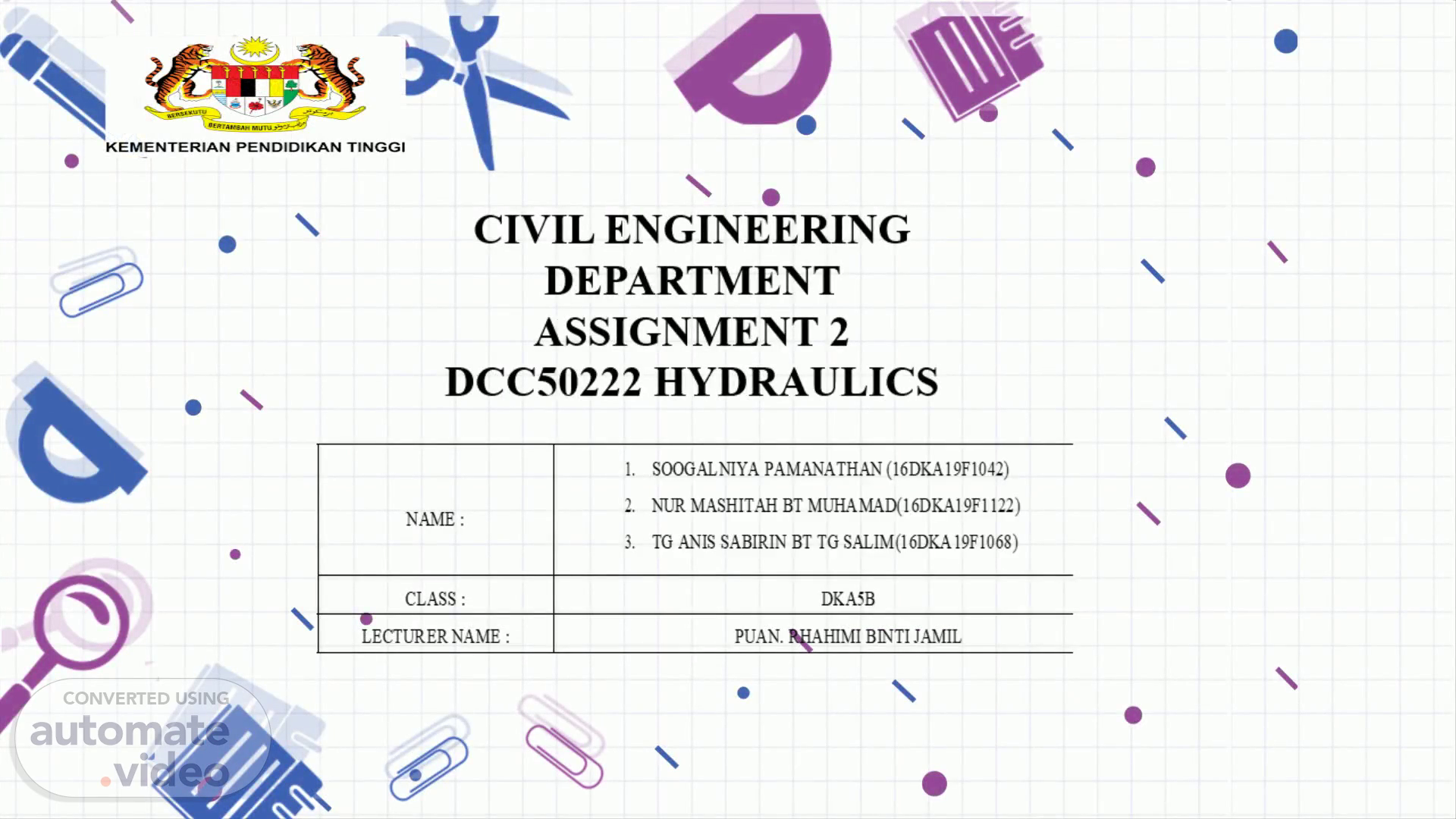Scene 1 (0s)
. abstract. abstract. abstract. abstract. CIVIL ENGINEERING DEPARTMENT ASSIGNMENT 2 DCC50222 HYDRAULICS.
Scene 2 (43s)
Question 1 Draw type of flow in open channel. ANSWER:.
Scene 3 (54s)
Question 2 i. A trapezoidal channel in Figure 2a with side slopes of 2/4 a depth of 2 m, a bottom width of 8 m and a channel slope of 0.0008 has a discharge of 65 mᵌ/s. Estimate the Manning’s value..
Scene 4 (1m 55s)
e7d195523061f1c0deeec63e560781cfd59afb0ea006f2a87ABB68BF51EA6619813959095094C18C62A12F549504892A4AAA8C1554C6663626E05CA27F281A14E6983772AFC3FB97135759321DEA3D70DBDC3F267C2A72094B3A9B655CEBC4A445944AB6F04D4566D28CDB915840310B983D9CB53150E02C53515D74B3A50BE16B4C01DB772DD75A6907B2F45F8222C2.
Scene 5 (3m 43s)
e7d195523061f1c0deeec63e560781cfd59afb0ea006f2a87ABB68BF51EA6619813959095094C18C62A12F549504892A4AAA8C1554C6663626E05CA27F281A14E6983772AFC3FB97135759321DEA3D70DBDC3F267C2A72094B3A9B655CEBC4A445944AB6F04D4566D28CDB915840310B983D9CB53150E02C53515D74B3A50BE16B4C01DB772DD75A6907B2F45F8222C2.
Scene 6 (5m 18s)
e7d195523061f1c0deeec63e560781cfd59afb0ea006f2a87ABB68BF51EA6619813959095094C18C62A12F549504892A4AAA8C1554C6663626E05CA27F281A14E6983772AFC3FB97135759321DEA3D70DBDC3F267C2A72094B3A9B655CEBC4A445944AB6F04D4566D28CDB915840310B983D9CB53150E02C53515D74B3A50BE16B4C01DB772DD75A6907B2F45F8222C2.
Scene 7 (5m 46s)
ii)Explain Froude number.\ ANSWER: l Is a measurement of bulk flow characteristic such as waves, sands bedforms , flow / depth interactions at a cross section between boulders l The denominator represents the speed of a small wave on the water surface relative to the speed of the water , called wave celerity.
Scene 8 (6m 19s)
iii.)A wide channel 3m carry Q (12m³/s), Identify critical depth and the minimum Specific Energy. ANSWER: Given : b= 3m Then , for rectangular channel : Q= 12m^3 yc = (q2/g)1/3 = (( 4^2)/9.81)1/3 = 1.18 m The critical depth is 1.18 m Discharge per unit witdh: for rectangular channel, Es,min =3/2 yc =3/2 x 1.18 = 1.77 q: Q/b The minimum specific energy is 1.77m = 12/3 =4 m^2/s.
Scene 9 (7m 10s)
Question 5 Hydraulic jumps occur at the downstream of the dam, explain deeply why hydraulic jump exist and give four (4) type of hydraulic jump. ·ANSWER: 1.To disspate the energy in water flow over dams , weirs and other hydraulic structures and thus prevent scouring down stream from the structures. 2.To increase weight on an apron and thus reduce uplift pressure under a masonry structure by raising the water depth on the apron 3.To recover head or raise the water level on the downstream side of a measuring flume and thus maintain high water level in the side of a measuring flume and in the channel for irrigation. 4.Types of hydraulic jump l lUndular hydraulic jump l lWeak jump’ l lSteady hydraulic jump l lOscillating hydraulic jump.
Scene 10 (7m 42s)
e7d195523061f1c0deeec63e560781cfd59afb0ea006f2a87ABB68BF51EA6619813959095094C18C62A12F549504892A4AAA8C1554C6663626E05CA27F281A14E6983772AFC3FB97135759321DEA3D7004FB075A8443E283A7673BBBDBFD88DFA513D62253E27B7E9FFF4379D8121322A85C7E16198ADF129F152EEF5340DE1ED504E252F53EAD1F847BC471C6326134.
